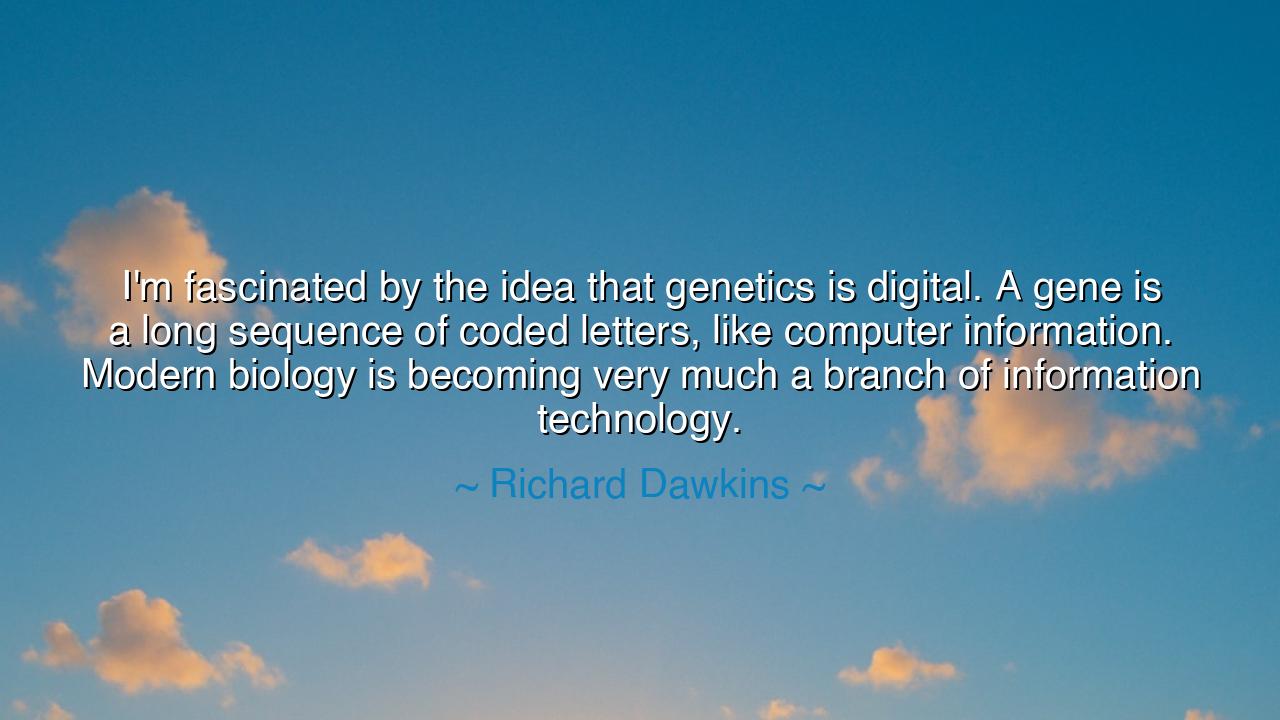
I'm fascinated by the idea that genetics is digital. A gene is a
I'm fascinated by the idea that genetics is digital. A gene is a long sequence of coded letters, like computer information. Modern biology is becoming very much a branch of information technology.






Hear the voice of Richard Dawkins, biologist and thinker, who gazed upon the mysteries of life and saw in them a reflection of our age. He proclaimed: “I’m fascinated by the idea that genetics is digital. A gene is a long sequence of coded letters, like computer information. Modern biology is becoming very much a branch of information technology.” In these words lies a revelation—that the secret of life itself is not chaos, but order; not mere chance, but a vast and intricate code, inscribed upon the fabric of living beings.
The meaning of his words is profound. Once, men thought of life as something mystical, its essence beyond comprehension. But the discovery of DNA unveiled a truth: within each cell lies a code, a series of instructions, written in letters not of ink but of nucleotides. These letters form the language of genetics, determining the shape, the function, and the destiny of all creatures. Dawkins, with the eye of both poet and scientist, saw that this language is digital—a system of discrete symbols, much like the 1s and 0s that govern our machines. Life itself, he suggests, is a program, and we are its living execution.
The origin of this insight springs from the great unraveling of the double helix by James Watson and Francis Crick in 1953. Their revelation—that the code of life was written in paired bases—marked the beginning of a new era. Over time, as computers grew in power, scientists realized that to read and interpret these codes required the logic of information technology. Thus, modern biology became inseparable from computing, its discoveries accelerated by algorithms, databases, and the digital tools of our time.
Consider the tale of the Human Genome Project, a vast undertaking begun in the late 20th century. For centuries, humanity pondered the question: what is written in the book of life? The answer could not be grasped by hand or mind alone; it required the marriage of biology and information technology. Supercomputers, algorithms, and data analysis decoded the three billion letters of the human genome, a task unimaginable without digital power. In this endeavor, Dawkins’ words were made flesh: life and information were seen as two faces of the same truth.
This understanding also reveals the heroic potential of science. With the recognition that life is digital, mankind now has the ability not only to read but also to edit the code of existence. Tools like CRISPR allow us to rewrite the letters of the genome, to correct errors that cause disease, to shape crops that withstand famine, and perhaps even to extend the boundaries of human health and longevity. Yet with this power comes grave responsibility, for to alter the script of life is to walk on sacred ground.
Dawkins’ insight reminds us, too, that the essence of technology is not separate from nature, but woven into it. Just as a computer program executes instructions, so does a cell follow its genetic code. In this light, modern biology is not merely a branch of information technology; it is the original information system, older than man, older than machines, stretching back billions of years to the dawn of life itself. Our computers are but crude imitations of the elegance already written into every living thing.
The lesson, O seekers, is this: look with awe upon the unity of life and knowledge. Do not separate biology and technology as two alien domains, but see them as entwined threads in the great tapestry of existence. Learn from both, and respect the power they grant. Approach the code of life with humility, with reverence, and with wisdom, for within it lies both the key to healing and the danger of hubris.
Therefore, remember Dawkins’ words: life is digital, and biology is information. Understand this, and you will glimpse the structure of existence itself. Treat this knowledge not as a weapon of greed, but as a gift to heal, to sustain, and to lift humanity. For we are both the readers and the written—living texts in the vast library of creation, entrusted with the sacred duty of preserving and guiding the code of life.






AAdministratorAdministrator
Welcome, honored guests. Please leave a comment, we will respond soon